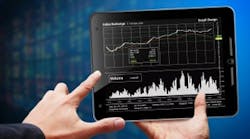"When viewing a trend display, an operator can zoom in or out along the time scale by using a two-finger pinch action. This changes the scale in proportion to the pinch motion, and it replaces the old method of selecting a zoom function and tapping buttons incrementally," adds Byrom.
The swipe function allows operators to review trend history by simply touching the screen and swiping in the reverse direction of the trend. Length of data playback is proportional to the swipe actions. Operators can also move trend scales and digital displays around the screen by touching and dragging them to a new location," explains Byrom.
[pullquote]"Two-point touch technology also supports handwritten text recognition for inputting messages and batch information. Overall, two-point touch technology condenses multiple touch-and-click operations into a single fast swipe action," concludes Byrom.
In addition to special-purpose components such as paperless recorders, an important process application for multi-touch will be Windows-based operator interface hardware and associated software applications such as HMI, alarm management and asset management. According to Louis Szabo, business development manager for Pepperl+Fuchs, here are the design parameters for a multi-touch Windows-based system.
The touchscreen technology must be capable of multi-touch, and the hardware and driver for the touchscreen technology must transmit the information as a human-interface device (HID), not a mouse input. The combination of driver, touchscreen and hardware must pass both Windows Logo Kit and Additional Qualification tests.
The operating system must interpret the information as HID. In a Windows environment, only Windows 7 and 8 have this capability. XP and Vista recognize touch as mouse inputs only. The application software must be compatible with multi-touch so that it can distinguish a swipe or zoom and act on the gesture.
Lisa Garrison, the managing director for human factors engineering at Acuite, describes how multi-touch could be used in a control room. "Operators don't like to type, therefore drag-and-drop gestures for building procedures or managing/creating batch recipes are potential applications. For example, an operations team could pull in all the required equipment information, task status, personnel activity and safety checks. This information could be mapped to a physical representation of the plant, and the team could then zoom in and expand the view as needed. This could all be displayed on a large screen so several people could see and work with the view, as well as smaller screens for individuals to build and interact with smaller subtasks or areas," explains Garrison.
Another supplier sees additional applications for multi-touch. "An operator could use one hand to open up a menu while using the other to set parameters, eliminating the need to jump back and forth between sub-menus," observes Robert Muehlfellner, the director of automation technology at B&R Industrial Automation.
"Multi-touch will allow operators to get where they need to go faster since complex menu layers can be eliminated. Handling lists is also simplified since the operator is able to simply scroll through them without having to rely on narrow scrollbars," notes Muehlfellner.
"Faulty operations caused by accidental contact can be avoided by requiring a second button to be pressed simultaneously with the other hand before a certain action can take place. While this won't completely replace fail-safe two-hand operation, multi-touch technology can be used in to prevent critical operating steps from being carried out unintentionally," explains Muehlfellner.




